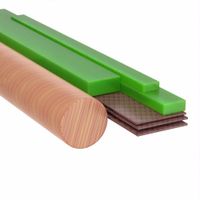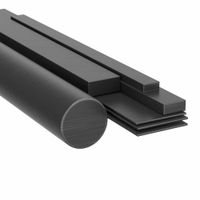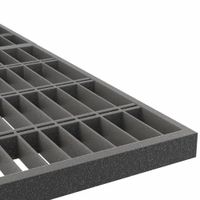Call +(254) 703 030 000 / 751 483 999 / 721 704 777
- Home
- Raw Materials
- Fiberglass Carbon Fiber Composites
.....Read More
Frequently Asked Questions
What is the difference between fiberglass and carbon fiber?
Fiberglass and carbon fiber are both composite materials used for their strength and lightweight properties, but they differ in composition, performance, and cost.
Fiberglass is made from fine strands of glass woven into a fabric and combined with a resin to form a composite. It is known for its flexibility, durability, and resistance to impact, corrosion, and moisture. Fiberglass is less expensive than carbon fiber, making it a popular choice for applications where cost is a significant factor, such as in automotive parts, boats, and construction materials.
Carbon fiber, on the other hand, is composed of thin strands of carbon atoms bonded together in a crystalline structure, which are then woven into a fabric and combined with a resin. Carbon fiber is renowned for its high strength-to-weight ratio, stiffness, and thermal expansion properties. It is significantly stronger and lighter than fiberglass, making it ideal for high-performance applications like aerospace, sports equipment, and luxury automotive components. However, carbon fiber is more expensive due to its complex manufacturing process.
In terms of performance, carbon fiber offers superior strength and stiffness compared to fiberglass, which translates to better performance in demanding applications. However, fiberglass is more impact-resistant and flexible, which can be advantageous in certain situations.
In summary, the choice between fiberglass and carbon fiber depends on the specific requirements of the application, including factors like budget, performance needs, and environmental conditions.
What are the advantages of using fiberglass?
Fiberglass offers several advantages, making it a popular choice in various industries. Firstly, it is lightweight yet strong, providing a high strength-to-weight ratio. This makes it ideal for applications where weight reduction is crucial, such as in automotive and aerospace industries. Secondly, fiberglass is highly resistant to corrosion, unlike metals, which makes it suitable for use in environments exposed to moisture, chemicals, or saltwater, such as in marine applications and chemical plants.
Additionally, fiberglass has excellent thermal insulation properties, which makes it useful in building construction for energy efficiency. It also has good electrical insulation properties, making it a preferred material in electrical and electronic applications. Fiberglass is also non-combustible and has a high melting point, contributing to its fire resistance, which is beneficial in safety-critical applications.
Moreover, fiberglass is versatile and can be molded into complex shapes, allowing for design flexibility in manufacturing. It is also relatively easy to repair, which can extend the lifespan of fiberglass products. The material is cost-effective, offering a balance between performance and price, and is often more affordable than metals or carbon fiber.
Fiberglass is also environmentally friendly, as it can be recycled and has a lower environmental impact during production compared to some other materials. Its durability and low maintenance requirements further contribute to its sustainability.
Overall, the combination of strength, durability, resistance to environmental factors, and cost-effectiveness makes fiberglass a valuable material across a wide range of applications.
How is carbon fiber made?
Carbon fiber is made through a series of processes that transform a precursor material, typically polyacrylonitrile (PAN), into strong, lightweight fibers. The process begins with the spinning of PAN into fibers, which are then stretched and oxidized in air at temperatures between 200-300°C. This step stabilizes the fibers by altering their molecular structure to prevent melting.
Next, the stabilized fibers undergo carbonization in an inert atmosphere, such as nitrogen, at temperatures ranging from 1,000 to 3,000°C. During carbonization, non-carbon atoms are expelled, and the remaining carbon atoms form tightly bonded carbon crystals, resulting in fibers that are over 90% carbon.
Following carbonization, the fibers may be subjected to surface treatment to enhance bonding with resins. This involves oxidizing the fiber surface to create functional groups that improve adhesion. The fibers are then coated with a sizing agent, which protects them during handling and processing.
Finally, the carbon fibers are spun into yarns or woven into fabrics, ready for use in various applications. The entire process requires precise control of temperature, tension, and chemical conditions to ensure the desired properties of strength, stiffness, and lightweight are achieved.
What are the applications of fiberglass reinforced plastics?
Fiberglass Reinforced Plastics (FRP) are widely used across various industries due to their high strength-to-weight ratio, corrosion resistance, and versatility. Here are some key applications:
1. **Construction**: FRP is used in building facades, roofing, and cladding due to its durability and resistance to weathering. It is also employed in reinforcing concrete structures and in the production of lightweight, corrosion-resistant rebar.
2. **Automotive and Transportation**: In the automotive industry, FRP is used for manufacturing body panels, bumpers, and other components to reduce vehicle weight and improve fuel efficiency. In public transportation, it is used in the construction of buses, trains, and trams for similar reasons.
3. **Marine**: FRP is extensively used in the marine industry for building boats, yachts, and other watercraft due to its resistance to saltwater corrosion and lightweight properties, which enhance speed and fuel efficiency.
4. **Aerospace**: The aerospace sector utilizes FRP for aircraft components, including fuselage sections, wing panels, and interior parts, to reduce weight and improve performance.
5. **Industrial**: FRP is used in manufacturing tanks, pipes, and ducts for chemical processing plants due to its resistance to corrosive chemicals. It is also used in cooling towers and scrubbers.
6. **Electrical and Electronics**: FRP is used in the production of circuit boards, enclosures, and insulators due to its non-conductive properties and resistance to electromagnetic interference.
7. **Sports and Recreation**: FRP is used in the production of sports equipment such as tennis rackets, golf clubs, and bicycles, offering strength and flexibility.
8. **Renewable Energy**: In the wind energy sector, FRP is used to manufacture wind turbine blades due to its lightweight and high-strength characteristics.
These applications highlight the versatility and adaptability of FRP across diverse sectors, driven by its unique material properties.
How does the strength of carbon fiber compare to fiberglass?
Carbon fiber is significantly stronger than fiberglass. The tensile strength of carbon fiber is typically around 290,000 to 700,000 psi, whereas fiberglass has a tensile strength of about 70,000 to 500,000 psi. This means carbon fiber can withstand greater forces without breaking. Additionally, carbon fiber is stiffer, with a higher modulus of elasticity, which means it deforms less under stress compared to fiberglass. This makes carbon fiber more suitable for applications requiring high strength-to-weight ratios, such as aerospace and high-performance automotive industries.
Fiberglass, while not as strong, is more flexible and less brittle, which can be advantageous in applications where impact resistance is important. It is also generally more cost-effective than carbon fiber, making it a popular choice for less demanding applications where cost is a significant factor.
In summary, carbon fiber offers superior strength and stiffness compared to fiberglass, but at a higher cost. Fiberglass provides a more economical option with adequate strength for many applications, especially where flexibility and impact resistance are beneficial.
What are the electrical insulating properties of fiberglass?
Fiberglass is a highly effective electrical insulator due to its unique properties. It is composed of fine glass fibers, which are non-conductive and provide excellent resistance to electrical currents. This makes fiberglass an ideal material for use in electrical and electronic applications where insulation is critical.
One of the primary insulating properties of fiberglass is its high dielectric strength. Dielectric strength refers to the maximum electric field a material can withstand without breaking down. Fiberglass can endure high voltages without allowing electrical currents to pass through, making it suitable for insulating electrical components and systems.
Fiberglass also exhibits low dielectric constant and low dissipation factor. The dielectric constant measures a material's ability to store electrical energy, while the dissipation factor indicates energy loss as heat. Fiberglass's low values in these areas mean it efficiently insulates without significant energy loss, maintaining performance over time.
Additionally, fiberglass is resistant to thermal and chemical degradation. It can withstand high temperatures without losing its insulating properties, making it suitable for environments with fluctuating or extreme temperatures. Its chemical resistance ensures that it remains stable and effective even when exposed to various chemicals and environmental conditions.
Fiberglass is also non-combustible and does not support combustion, adding a layer of safety in electrical applications. Its mechanical strength and durability further enhance its suitability as an insulator, providing long-lasting performance and reliability.
Overall, the combination of high dielectric strength, low dielectric constant, thermal and chemical resistance, and non-combustibility makes fiberglass an excellent choice for electrical insulation in a wide range of applications.
How do you cut and shape fiberglass materials?
To cut and shape fiberglass materials, follow these steps:
1. **Preparation**: Wear protective gear, including gloves, goggles, and a dust mask, to protect against fiberglass dust and sharp edges. Work in a well-ventilated area to minimize inhalation of dust.
2. **Marking**: Use a marker or chalk to outline the desired shape on the fiberglass surface. A straightedge or template can help ensure accuracy.
3. **Cutting Tools**: Choose the appropriate cutting tool based on the thickness and type of fiberglass:
- For thin sheets, use a utility knife or a pair of heavy-duty scissors. Score the surface with the knife and snap it along the line.
- For thicker materials, use a jigsaw with a fine-toothed blade, a circular saw with a carbide-tipped blade, or a rotary tool with a fiberglass cutting wheel.
4. **Cutting Process**: Secure the fiberglass firmly to prevent movement. Cut slowly and steadily along the marked line to avoid splintering. If using power tools, maintain a consistent speed and pressure.
5. **Shaping**: After cutting, shape the edges using a file, rasp, or sandpaper. Start with a coarse grit to remove excess material and switch to a finer grit for smoothing. For complex shapes, a rotary tool with sanding attachments can be useful.
6. **Finishing**: Clean the cut and shaped fiberglass with a damp cloth to remove dust. If necessary, apply a sealant or resin to the edges to prevent fraying and enhance durability.
7. **Safety Cleanup**: Dispose of fiberglass dust and scraps properly. Clean your workspace and tools to prevent contamination and ensure safety for future use.
What are the common uses of carbon fiber reinforced plastics?
Carbon fiber reinforced plastics (CFRP) are widely used across various industries due to their high strength-to-weight ratio, stiffness, and resistance to corrosion. Here are some common applications:
1. **Aerospace**: CFRP is extensively used in the aerospace industry for manufacturing aircraft components such as fuselages, wings, and tail sections. Its lightweight nature contributes to fuel efficiency and improved performance.
2. **Automotive**: In the automotive sector, CFRP is used in high-performance vehicles and sports cars to reduce weight and enhance speed and fuel efficiency. Components like body panels, chassis, and interior parts often utilize CFRP.
3. **Sports Equipment**: Many sports equipment, including bicycles, tennis rackets, golf clubs, and hockey sticks, are made from CFRP. The material provides strength and flexibility, enhancing performance and durability.
4. **Wind Energy**: CFRP is used in the production of wind turbine blades. Its lightweight and strong properties allow for longer blades, which can capture more wind energy and improve efficiency.
5. **Marine**: In the marine industry, CFRP is used for constructing hulls and masts of boats and yachts. Its resistance to corrosion and lightweight nature make it ideal for marine applications.
6. **Construction**: CFRP is used in the construction industry for strengthening and retrofitting structures. It is applied to bridges, buildings, and other infrastructure to enhance load-bearing capacity and extend service life.
7. **Medical Devices**: CFRP is used in medical devices and equipment, such as prosthetics and imaging machines, due to its biocompatibility and radiolucency, which allows for clear imaging results.
8. **Consumer Electronics**: CFRP is used in the production of lightweight and durable components for laptops, smartphones, and other electronic devices.
These applications leverage the unique properties of CFRP to improve performance, efficiency, and longevity across various fields.
How do fiberglass and carbon fiber perform in high-temperature environments?
Fiberglass and carbon fiber have distinct performance characteristics in high-temperature environments due to their different material properties.
Fiberglass is made from fine fibers of glass and is known for its good thermal insulation properties. It can generally withstand temperatures up to about 1,000°F (538°C) before it begins to soften and lose structural integrity. In high-temperature environments, fiberglass maintains its shape and strength better than many other materials, but it can become brittle over time when exposed to extreme heat. Its thermal resistance makes it suitable for applications like insulation, fireproofing, and in environments where moderate heat resistance is required.
Carbon fiber, on the other hand, is composed of carbon atoms bonded together in a crystalline structure, which gives it exceptional strength and stiffness. Carbon fiber can withstand much higher temperatures than fiberglass, often up to 2,000°F (1,093°C) or more, depending on the specific resin system used. It retains its mechanical properties at elevated temperatures, making it ideal for high-performance applications such as aerospace, automotive, and sporting goods. However, the resin matrix in carbon fiber composites can degrade at lower temperatures, so the choice of resin is crucial for high-temperature applications.
In summary, while both materials perform well in high-temperature environments, carbon fiber generally offers superior heat resistance and mechanical properties compared to fiberglass. However, the choice between the two often depends on the specific application requirements, including temperature range, mechanical stress, and cost considerations.
What are the cost differences between fiberglass and carbon fiber materials?
Fiberglass and carbon fiber are both composite materials used in various industries, but they differ significantly in cost due to their properties and manufacturing processes.
Fiberglass is generally much cheaper than carbon fiber. The cost of fiberglass is lower because the raw materials, primarily silica sand, are abundant and inexpensive. The manufacturing process for fiberglass is also less complex and energy-intensive, contributing to its affordability. Fiberglass is often used in applications where cost is a significant factor, such as in the construction of boats, automotive parts, and certain sporting goods.
Carbon fiber, on the other hand, is considerably more expensive. The production of carbon fiber involves a complex process of carbonizing polyacrylonitrile (PAN) or pitch-based fibers at high temperatures, which is energy-intensive and costly. The raw materials for carbon fiber are also more expensive than those for fiberglass. Additionally, carbon fiber's superior strength-to-weight ratio, stiffness, and resistance to fatigue and environmental factors make it a premium material. These properties justify its higher cost in applications where performance is critical, such as in aerospace, high-performance automotive, and advanced sporting equipment.
In summary, the cost difference between fiberglass and carbon fiber is primarily due to the raw material costs and the complexity of the manufacturing processes. Fiberglass is more cost-effective for applications where budget constraints are a priority, while carbon fiber is chosen for high-performance applications where its superior properties can be fully utilized despite the higher cost.


